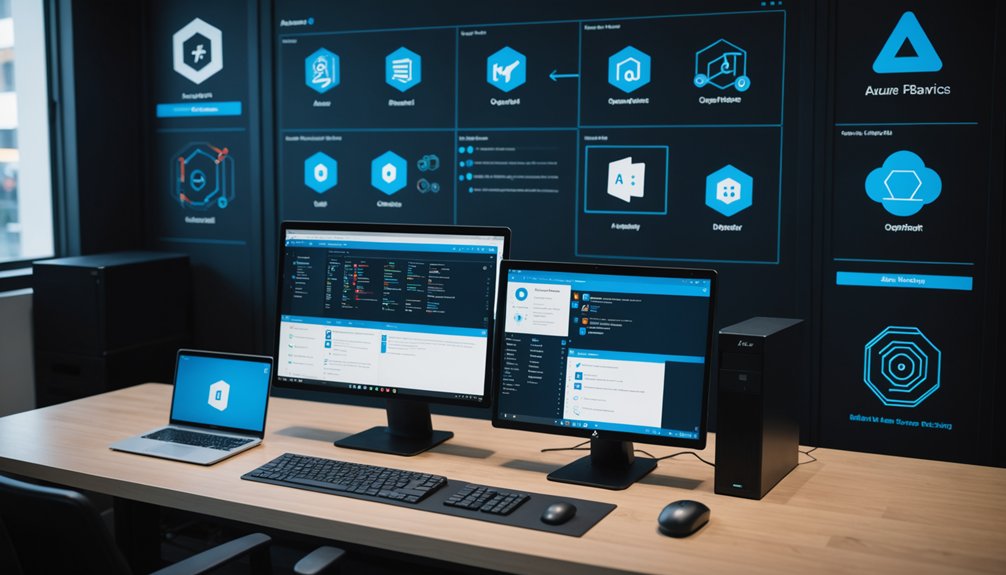Setting up Azure OpenAI Services requires a paid Azure account—forget the free tier. Head to portal.azure.com, search "Azure OpenAI," and follow the prompts. Choose a non-free subscription, pick or create a resource group, and give your resource a unique name. Nothing fancy here—just clicking through options. Set your pricing tier based on expected usage. After deployment completes, hit "Go to resource" and you're in. The real fun starts when you access those AI models.

Setting up Azure OpenAI Services isn't rocket science. Anyone with basic technical skills can get it done, though there are a few hoops to jump through first. You'll need an Azure account—either a personal Microsoft account or something from your workplace will do. Just remember: the free tier won't cut it. Azure OpenAI demands payment upfront.
Don't be intimidated—Azure OpenAI setup is straightforward, but your wallet needs to be ready.
Getting started requires proper permissions and identity verification. Microsoft wants to make sure you're a real person with real money. They'll check your credit card details. No surprises there—AI doesn't run on hopes and dreams. It runs on cold, hard cash. Like any machine learning model, the system requires careful preparation and configuration before it can be useful.
The actual setup process begins at portal.azure.com. Log in, search for "Azure OpenAI," and hit that create button like you mean it. Pick your subscription—again, not the free one—and decide on a resource group. Using an existing one saves time. Creating a new one keeps things organized. Your call. Similar to implementing RESTful APIs, you'll need to carefully plan your resource structure and endpoints.
Naming your resource matters. Be descriptive but unique. Nobody wants to sort through a dozen resources called "Test" or "MyAI." That's just sloppy. Corporate email addresses are preferred but not mandatory. Individual users can make do without corporate credentials.
The portal walks you through the remaining configuration steps. It's fairly straightforward—click, type, click some more. The system isn't trying to trick you. Follow the prompts and you'll be fine. Once configured, you gain access to powerful AI models ready for implementation in various applications. During this process, you'll need to set your pricing tier based on your expected usage and budget constraints. After deployment completes successfully, you'll see the Go to resource button that takes you directly to your new Azure OpenAI Service.
What's interesting is that despite the technical nature of AI services, the setup process is deliberately simplified. Microsoft knows their audience isn't exclusively composed of rocket scientists. Regular developers need access too.
After completion, you'll have a working Azure OpenAI service at your disposal. No magic involved—just a straightforward process that requires attention to detail and a valid payment method. The hard part comes after setup: figuring out what to do with all that artificial intelligence at your fingertips.
Frequently Asked Questions
How Does Azure Openai Pricing Compare to Standard Openai Services?
Azure OpenAI and standard OpenAI both use token-based pricing with no upfront costs.
Standard OpenAI is cheaper for fine-tuning smaller models, while Azure becomes more cost-effective when running models at scale.
Azure offers more flexible payment options including provisioned throughput units and reservations.
It's also packed with better security features for regulated industries.
Enterprise users get more bang for their buck with Azure's SLAs and support.
Can I Migrate Existing Openai Projects to Azure Openai?
Yes, migration is possible but it's manual. No automatic tools here. Developers need to update API keys, endpoints, and possibly code structure.
The OpenAI v1.x library introduces breaking changes, so there's that hurdle too. Security features in Azure mean extra steps.
Testing is essential before moving production apps. Despite the headaches, most find the shift worthwhile for Azure's scalability, compliance benefits, and integration options.
What Security Certifications Does Azure Openai Comply With?
Azure OpenAI boasts quite the security resume.
ISO 27001 certification? Check.
HIPAA compliance? You bet.
They've even scored a FedRAMP High P-ATO in US Commercial regions—no small feat.
The service plays nicely with various data privacy laws too.
Plus, there's Role-Based Access Control for managing who gets to touch what.
Pretty thorough for something that could potentially write your company's next slogan.
How Do Azure Openai's Quotas and Rate Limits Work?
Azure OpenAI's quota system works regionally, assigning Tokens-per-Minute (TPM) per model. Simple, really.
Quotas are shared among deployments in the same subscription and region. Need more? Ask for it.
Rate limits are automatic—roughly 6 Requests-per-Minute per 1,000 TPM. The system checks constantly, not just once a minute.
Go over your limit? Boom. 429 error. Wait till it resets or adjust your quota.
Can Azure Openai Be Deployed in Air-Gapped or Hybrid Environments?
Azure OpenAI can operate in hybrid environments using Azure Arc.
It's doable but complex. For air-gapped setups? Officially, no. Microsoft doesn't currently support completely isolated deployments.
The models need regular updates and internet connectivity for proper functioning. Some organizations work around this with controlled access points, but it's not straightforward.
Security-focused agencies are pushing for better air-gapped solutions, but they're not quite there yet.




